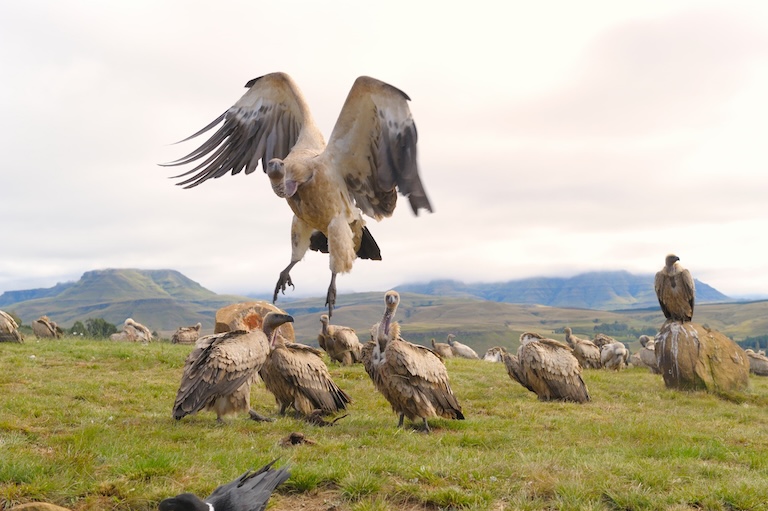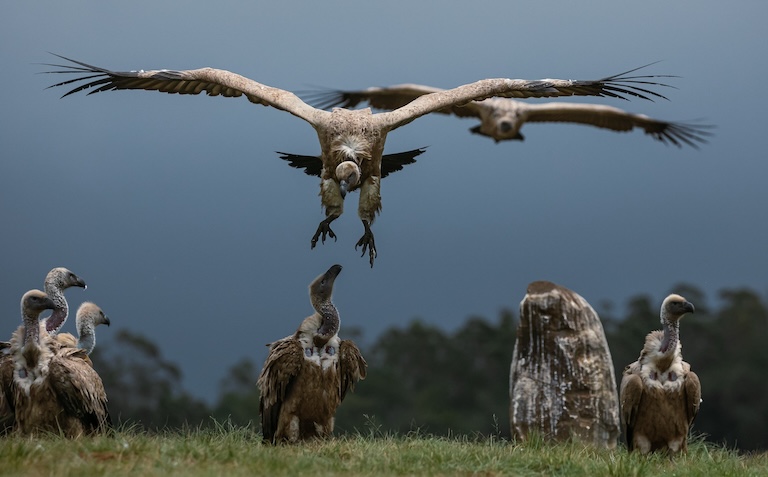Cape Vulture Profile
In 1952, Bertrand Russel issued an analogy for the flimsiness of religious beliefs, drawing attention to the burden of proof being on the person making the claim.
It discussed the concept of an orbiting teapot, too small to be seen by telescopes, and pointed to the fact that the assertion could not be disproved.
Russel’s teapot (may, or) may not exist, but it can be stated with some confidence that there is a kettle circling above the Southern Cape in Africa, and we have the video evidence to prove it.
That is, a group of vultures, which is – for some reason – known as a kettle. And the heaviest among these huge birds are likely to be Cape Vultures.

Cape Vulture Facts Overview
| Habitat: | Forest, Savanna, Shrubland, Grassland, Rocky areas, desert |
| Location: | Southern Africa |
| Lifespan: | 25 in the wild, up to 75 in captivity |
| Size: | 96–115 cm (38–45 in) long |
| Weight: | 7–11 kg (15–24 lb) |
| Colour: | Creamy-buff, with dark wing tips and tail; naked, dark neck |
| Diet: | Carrion, large mammals |
| Predators: | Leopards, jackals, crocodiles |
| Top Speed: | 62 km/h (39 mph) |
| No. of Species: | 1 |
| Conservation Status: | Vulnerable (IUCN) |
Cape vultures are some of the heaviest griffon vultures you’ll find. They’re well adapted for life at altitude, and nest as high as 3km up the rock faces of the Southern Cape, among other places.
They are exclusively carrion-feeders, but that doesn’t protect them from persecution by humans, nor the inadvertent poisonings that come from livestock farming.
Sadly, this is a struggling bird species, who – while often quite rude – don’t deserve total eradication.
Interesting Cape Vulture Facts
1. They’re griffon vultures
Cape vultures are members of the Gyps genus, a group of vultures that span much of the Old World, including Asia and Europe.
They are known for their slender necks, and skinny heads, and usually have downy feathers around their heads.
This genus contains the well-known white-rumped vultures, the slender-billed vultures, and the incredible Himalayan vultures, yet among all of this royalty, the Cape vulture fits in perfectly. 1

2. They’re big
Cape vultures are big birds, and while they’re not quite as large and wide-winged as the largest of their community members the lappet-faced vultures, they are heavier.
They’re not slouch in size, either, though. Cape vultures can have a wingspan of over 2.6 metres, and weigh up to 11 kg. They are the heaviest African vulture and the third largest of the Old-World vulture species.
3. They’re high-altitude specialists
This weight doesn’t seem to hold them back when it comes to flight, as their huge wings help them reach dizzying altitudes.
They even nest in towering rockfaces, up to 3km above sea level.
When on the move, these heavy birds can cover considerable distance, and one population in Namibia was tagged across a range of 22,500 km2.
4. They’re fast!
Another Namibian study tracked their movements and documented an average flight speed of up to 62 km/h, which is already impressive for such a heavy bird, but the highest recorded speed came back at an alarming 127 km/h for three individuals.
It appears these birds get up late, and forage from around 10:00 am until about 18:00, likely waiting in the morning for the sun to heat up the air currents needed to get such a big bird up there in the first place.

5. They can be jerks
This surprising athleticism appears to have gone to their heads, and the feeding behaviour in this species is one of squabbling and bullying.
In contrast to the calmer species, Cape vultures will not only peck and abuse conspecifics around a meal but also go for people who are looking after them. Captive vultures aim for the eyes when being fed, and will try to make their dominance known.
Unfortunately, keeping these incredible birds in captivity is becoming more and more of a necessity. 2 3
6. They’re threatened from all sides
There are several major mortality factors affecting this species and livestock farming brings four big ones:
First, their habitats are being converted to farmland.
This reduces nesting options, and leads to the second issue, which is a lack of food; with landscapes converted, wild animal populations drop and the vultures have nothing to eat.
So, they feed on livestock, which introduces the third issue of toxicity. Livestock are often treated with diclofenac, which is desperately toxic to vultures, and they have seen worldwide and terrifying declines in number since it was introduced.
But there’s the consequent issue of revenge killings, too. Farmers seeing a cape vulture eating their sheep may have no idea that the bird had nothing to do with its death (and in fact is helping the farmer avoid disease spreading to the other animals) and will assume the vulture is the culprit.
This leads to deliberate poisonings or shootings and compounds the problem.
But outside of agriculture, wind turbines, electrical grids, and various other human structures are contributing the decline of large birds, including this one. As a result, the species is now Vulnerable. 4
7. But they’re better off than they were
This sounds bad – and it is – but it has been worse. Certain efforts have made a positive impact on vulture numbers in Africa, some of them as simple as marking out the power lines with balls so the birds can see and avoid them.
As recently as 2017, the Cap vulture was categorised as Endangered by the IUCN, but they are now moved up to Vulnerable status.
However, the complexities of these rankings mean that an improvement in their situation sometimes results in a drop in protections, and it’s thought they are still in decline.

Cape Vulture Fact-File Summary
Scientific Classification
| Kingdom: | Animalia |
| Phylum: | Chordata |
| Class: | Aves |
| Order: | Accipitriformes |
| Family: | Accipitridae |
| Genus: | Gyps |
| Species: | coprotheres |
Fact Sources & References
- “Gyps”, Bird Guides.
- Tekweni (2018), “It Was Just a Bird Bath… Until the Crocodile Struck”, YouTube.
- Nature Documentaries TV (2018), “Cape Vulture:The Largest South African Raptor – Wildlife Documentary”, YouTube.
- “Cape Vulture”, IUCN Red List.
